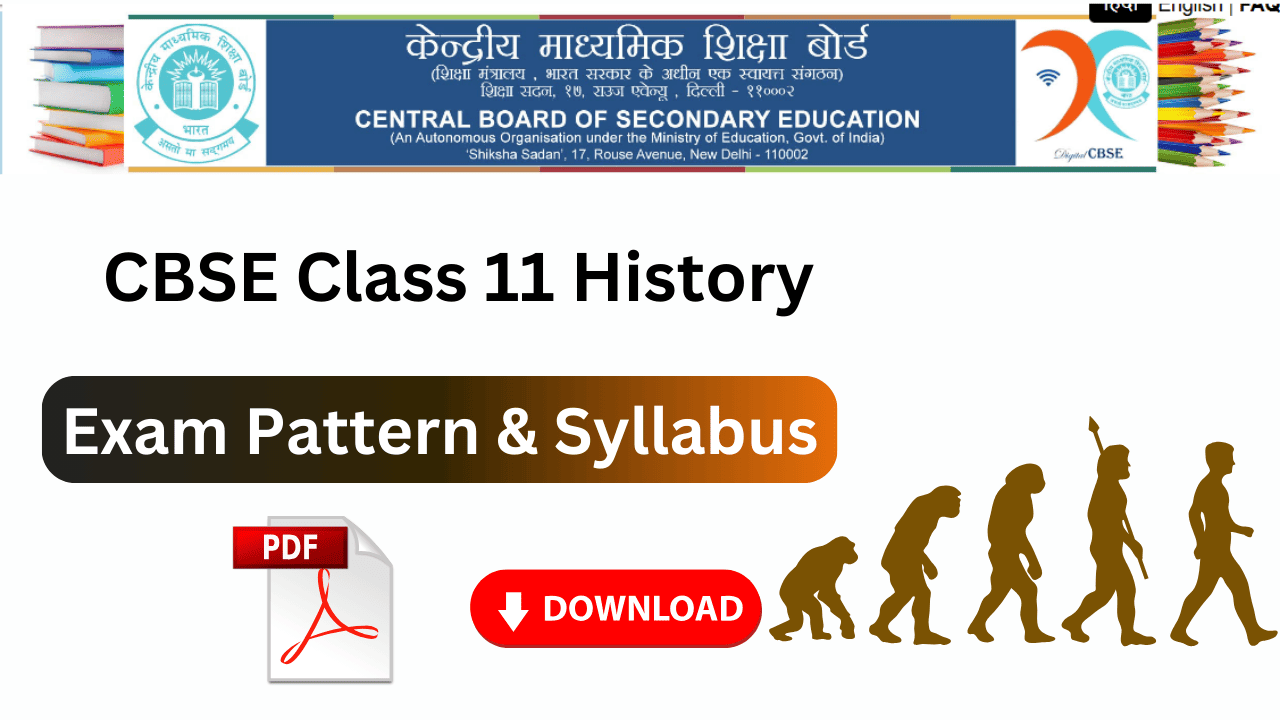Updated CBSE Class 11 History Syllabus for 2025-26 – Get the latest chapter-wise syllabus, marking scheme, and study tips. Download the official PDF at the end!
Overview of CBSE Class 11 History Syllabus 2025-26
The Class 11 CBSE syllabus for History plays a crucial role in board exams and competitive exams like CUET. This year, CBSE has introduced competency-based questions and a revised weightage system to encourage conceptual learning over rote memorization.
| Board | CBSE |
| Class | 11 |
| Session | 2025-26 |
| Subject | History |
| Content-Type | Syllabus/Curriculum |
| Official Website | https://cbseacademic.nic.in |
COURSE STRUCTURE: CLASS XI HISTORY (2025-26)
- Theory: 80 Marks
- Duration: 3 Hours
- Project Work: 20 Marks
- Total: 100 Marks
Mark Distribution by Section and Theme
| Section | Theme No. | Theme Title | Marks |
|---|---|---|---|
| Reading of World History | Introduction of World History | ||
| I. Early Societies | |||
| 1 | Writing and City Life | 10 | |
| II. Empires | |||
| 2 | An Empire Across Three Continents | 10 | |
| 3 | Nomadic Empires | 10 | |
| III. Changing Traditions | |||
| 4 | The Three Orders | 10 | |
| 5 | Changing Cultural Traditions | 10 | |
| IV. Towards Modernisation | |||
| 6 | Displacing Indigenous Peoples | 10 | |
| 7 | Paths to Modernisation | 15 | |
| Map | - | Map Work of Related Themes | 05 |
| Theory Total | 80 | ||
| Project Work | 20 | ||
| Grand Total | 100 |
Note: Maps available on the official Government of India website may be used.
Course Content
Section I: Early Societies
- Timeline I (6 MYA to 1 BCE): Understanding the concept of chronology.
- Theme 1: Writing and City Life
- Focus: Iraq, 3rd Millennium BCE
- Growth of towns, Nature of early urban societies, Historians’ debate on uses of writing.
- Learning Outcomes:
- Elucidate interwoven social and cultural aspects of civilization through writings.
- Analyse outcomes of a sustained writing tradition.
- Explain the connection between human civilization growth and writing.
Section II: Empires
- Timeline II (c. 100 BCE to 1300 CE): Understanding periods in order of time.
- Theme 2: An Empire Across Three Continents
- Dynamics of the Roman Empire: Polity, economy, society, culture.
- Implications of Roman contact with subcontinent empires, slavery.
- Learning Outcomes:
- Explain and relate Roman Empire dynamics.
- Analyse cultural transformation and impact of slavery.
- Theme 3: Nomadic Empires
- Living patterns of nomadic pastoralist society.
- Rise and growth of Genghis Khan as an oceanic ruler.
- Socio-political and economic changes under his descendants.
- Learning Outcomes:
- Identify nomadic pastoralist patterns.
- Trace Genghis Khan’s rise and impact.
- Distinguish Mongolian vs. global perspectives on Genghis Khan.
Section III: Changing Traditions
- Timeline III (c. 1300 to 1700)
- Theme 4: The Three Orders
- Aspects of feudalism: First, Second, Third, and Fourth Orders.
- Ancient slavery vs. serfdom, 14th-century crisis, rise of nation-states.
- Learning Outcomes:
- Explain feudalism’s myriad aspects.
- Relate slavery and serfdom.
- Assess the 14th-century crisis and nation-state emergence.
- Theme 5: Changing Cultural Traditions
- Renaissance, Reformation, Scientific Revolution, Age of Exploration: Causes, events, effects.
- Italian cities: Renaissance, Humanism, Realism.
- Women’s condition, architectural/artistic/literary developments.
- Roman Catholic Church’s response to Protestant Reformation.
- Learning Outcomes:
- Analyse causes and effects of major cultural shifts.
- Relate facets of Italian cities to Renaissance characteristics.
- Compare women’s conditions, evaluate church responses.
Section IV: Towards Modernisation
- Timeline IV (c. 1700 to 2000): Remember and understand the timeframe.
- Theme 6: Displacing Indigenous Peoples
- Process of displacement in America and Australia.
- European settlement realms, lives/roles of indigenous peoples.
- Learning Outcomes:
- Evaluate displacement processes and their impact.
- Analyse European settlement in America and Australia.
- Compare indigenous peoples’ lives across continents.
- Theme 7: Paths to Modernisation
- Note: Japan, China, and Korea must all be taught due to their importance.
- Nationalist upsurge in China: Dr. Sun Yat Sen to Mao Zedong (Communism era).
- Chinese path under Deng Xiaoping and Zhou Enlai (rigid Communism to liberal Socialism).
- Histories of China and Japan: Imperialism to modernisation.
- Japanese nationalism pre- and post-World War II.
- Learning Outcomes:
- Summarise China’s nationalist and Communist evolution.
- Analyse China’s modernisation transformation.
- Deduce China and Japan’s paths from imperialism to modernisation.
- Analyse Japanese nationalism domains.
Question Paper Design
| Section | Theme | MCQ (1 Mark) | SA (3 Marks) | LA (8 Marks) | Source-Based (4 Marks) | Total |
|---|---|---|---|---|---|---|
| I. Early Societies | Theme 1 | 3 | 1 | 0 | 1 | 10 |
| II. Empires | Themes 2-3 | 4 | 0 | 2 | 0 | 20 |
| III. Changing Traditions | Themes 4-5 | 6 | 2 | 0 | 2 | 20 |
| IV. Towards Modernisation | Themes 6-7 | 8 | 3 | 1 | 0 | 25 |
| Map | Map Work | - | - | - | - | 05 |
| Total | 21 × 1 = 21 | 6 × 3 = 18 | 3 × 8 = 24 | 3 × 4 = 12 | 80 |
Project Work (20 Marks)
- Details to be specified as per curriculum guidelines.
Download CBSE Class 11 History Syllabus 2025-26 PDF
Click the button below to download the official CBSE syllabus PDF for 2025-26.
📂 Download CBSE Class 11 History Syllabus PDF
Related Guides
CBSE Class 11 Syllabus – All Subjects
Stay Updated!
Join our Telegram/WhatsApp group for CBSE updates, free notes, and exam tips!
Bookmark this page & keep revising smartly!
